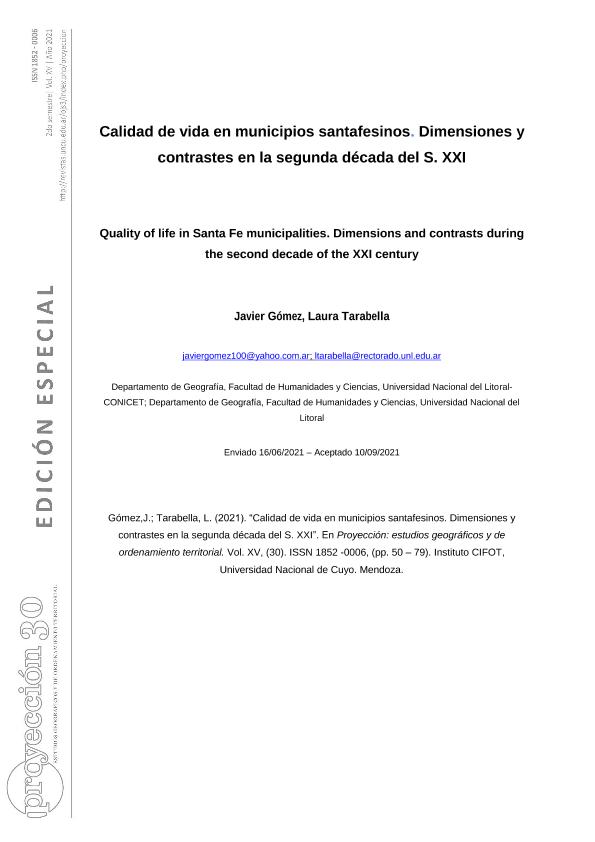Artículo
Este trabajo propone un índice de calidad de vida (ICV) estructurado a partir de tres dimensiones “socioeconómica”, “infraestructura y servicios” y “ambiental” para evaluar y clasificar la situación de 55 municipios existentes actualmente en Santa Fe (Argentina) y de este modo lograr desentrañar contrastes territoriales. A su vez, se analiza si el comportamiento dispar del ICV se puede asociar con la magnitud, crecimiento o localización regional de los municipios. Las fuentes de información son el Censo Nacional de Población, Hogares y Viviendas de 2001 y 2010 (INDEC) y demás fuentes secundarias del sistema estadístico nacional y provincial, más información secundaria autogenerada. Los resultados muestran heterogéneo comportamiento del ICV entre los municipios y dispar influencia de las dimensiones consideradas. Los municipios con mayor ICV se ubican en el Centro y el Sur provincial y son de magnitud poblacional ‘media’. En el centro-sur, el rezago del ICV en las áreas metropolitanas de Rosario y Santa Fe es atribuible al déficit de infraestructura y servicios. En el norte, el bajo ICV se relaciona con el bajo comportamiento de la dimensión socioeconómica. Estos aportes brindan lineamientos para pensar un ordenamiento territorial sustentado en el desafío de reducir las asimetrías a escala provincial y metropolitana. This study proposes a quality of life index (QLX) structured on three dimensions "socioeconomic", "infrastructure and services" and "environmental". It evaluates and classifies the situation of 55 municipalities in Santa Fe (Argentina) and finds territorial contrasts. In turn, it is analyzed if the QLX can be associated with the magnitude, growth or regional location of the municipalities. The information sources are the 2001 and 2010 National Population, Household and Housing Census, and other data collection of the national and provincial statistics system as well as some secondary data produced by the authors. The results show dissimilar QLX between municipalities and a different influence of the dimensions included in this study. The municipalities with the highest QLX are located in the Center and the South of the province and are of ‘medium’ population size. In the center and south regions, the ICV lag in the metropolitan areas of Rosario and Santa Fe is attributable to the deficit of infrastructure and services. In the north, on the other hand, it is related to the low performance of the socioeconomic dimension. These contributions provide guidelines to think about a territorial management based on the challenge of reducing contrasts at provincial and metropolitan scales.
Calidad de vida en municipios santafesinos: Dimensiones y contrastes en la segunda década del S. XXI
Título:
Quality of life in Santa Fe municipalities: Dimensions and contrasts during the second decade of the XXI century
Fecha de publicación:
12/2021
Editorial:
Universidad Nacional de Cuyo. Facultad de Filosofía y Letras. Instituto de Cartografía, Investigación y Formación para el Ordenamiento Territorial
Revista:
Proyección
ISSN:
1852-0006
Idioma:
Español
Tipo de recurso:
Artículo publicado
Clasificación temática:
Resumen
Palabras clave:
CALIDAD DE VIDA
,
INDICE
,
POBLACION
,
MUNICIPIOS
Archivos asociados
Licencia
Identificadores
Colecciones
Articulos(CCT - SANTA FE)
Articulos de CTRO.CIENTIFICO TECNOL.CONICET - SANTA FE
Articulos de CTRO.CIENTIFICO TECNOL.CONICET - SANTA FE
Citación
Gomez, Nestor Javier; Tarabella, Laura; Calidad de vida en municipios santafesinos: Dimensiones y contrastes en la segunda década del S. XXI; Universidad Nacional de Cuyo. Facultad de Filosofía y Letras. Instituto de Cartografía, Investigación y Formación para el Ordenamiento Territorial; Proyección; 15; 30; 12-2021; 50-79
Compartir




